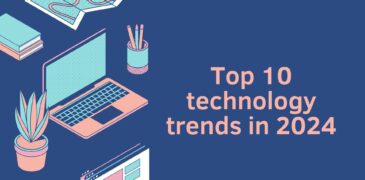In 2024, technology continues its rapid evolution, shaping every aspect of our lives. From artificial intelligence and quantum computing to augmented reality and sustainable energy solutions, emerging trends are revolutionizing industries worldwide. The convergence of digitalization and sustainability drives innovation, while advancements in biotechnology and space exploration push the boundaries of human achievement. As we navigate the digital landscape, privacy and ethical considerations remain paramount, urging stakeholders to prioritize responsible development and equitable access to technology. In this dynamic era, embracing these trends promises to redefine how we live, work, and interact with the world around us.
Top Technology Trends in 2024
Platform engineering
Platform engineering is a strategic discipline focused on crafting efficient toolchains and workflows for cloud-native software engineering organizations. At the forefront of this practice is Luca Galante, a Product expert at Humanitec. The core objective is to empower developers through self-service capabilities in the complex landscape of cloud-native applications. The result is an “Internal Developer Platform” (IDP) that seamlessly integrates various technologies, streamlining the entire application lifecycle.
This IDP not only reduces cognitive load for developers but also aids operations by structuring setups and fostering developer self-service. With a well-executed platform engineering approach, golden paths and paved roads are created, aligning with individual developers’ preferred abstraction levels and ensuring a harmonious interaction with the IDP. Ultimately, platform engineering optimizes efficiency, minimizes complexities, and enhances collaboration, providing a robust foundation for agile and innovative software development in the dynamic cloud-native era.
Intelligent applications
Intelligent applications represent a transformative wave in technology, leveraging advanced capabilities such as artificial intelligence (AI) and machine learning (ML) to enhance performance and deliver a more intuitive user experience. The features of intelligent applications encompass a range of cutting-edge functionalities. They often include natural language processing, enabling seamless interaction between users and applications through speech and text. Machine learning algorithms empower these applications to adapt and improve over time, learning from user behavior and evolving to meet changing requirements.
The benefits of intelligent applications are profound. Enhanced automation streamlines processes, reducing manual effort and increasing efficiency. Predictive analytics allows for data-driven insights, enabling businesses to make informed decisions. Personalization is a key advantage, as these applications tailor experiences based on individual preferences, fostering user engagement and satisfaction. Improved problem-solving capabilities and quick decision-making are also notable benefits, leading to a more responsive and agile operation.
Industry cloud platforms
Industry cloud platforms are specialized cloud computing solutions tailored to meet the unique needs and challenges of specific industries. These platforms offer a comprehensive suite of features designed to optimize operations, enhance collaboration, and drive innovation within a particular sector. Key features include industry-specific applications, compliance management tools, and data analytics capabilities. These platforms often integrate with existing systems, providing a seamless transition to cloud-based solutions while addressing industry-specific requirements.
The benefits of industry cloud platforms are extensive. They streamline workflows by providing specialized tools that cater to the nuances of a particular industry, resulting in increased efficiency and productivity. With a focus on compliance and regulatory standards, these platforms help organizations navigate complex industry regulations, ensuring data security and legal adherence. Real-time analytics and reporting empower informed decision-making, while collaboration features facilitate communication and coordination across the supply chain.
Blockchain
Blockchain technology is a decentralized and distributed ledger system that revolutionizes the way data is stored and transactions are conducted. Key features of blockchain include transparency, immutability, and security. The ledger is maintained across a network of computers, ensuring that each participant has access to the same information, promoting transparency and reducing the risk of fraud. Immutability ensures that once a block of data is added to the chain, it cannot be altered or tampered with, providing a high level of data integrity.
One of the primary benefits of blockchain is enhanced security. The decentralized nature of the technology, combined with cryptographic techniques, makes it resistant to hacking and fraud. Additionally, smart contracts, self-executing contracts with coded terms, automate and enforce agreements, reducing the need for intermediaries and enhancing efficiency.
Internet of Things
The Internet of Things (IoT) is a transformative technological paradigm that connects everyday devices to the internet, enabling them to collect and share data. Key features of IoT include connectivity, data exchange, and sensor integration. IoT devices, ranging from smart thermostats to industrial sensors, communicate with each other to provide real-time information and insights.
IoT contributes to data-driven decision-making by collecting and analyzing vast amounts of data generated by connected devices. Enhanced connectivity and communication between devices result in increased collaboration and streamlined operations. In smart homes, IoT devices enhance convenience through automation, allowing users to control and monitor their home environment remotely.
Robotics
The adoption of robotics is witnessing significant trends across industries, with a focus on enhancing automation and efficiency. Key features driving robotics adoption include advanced sensors, artificial intelligence, and collaborative capabilities. Modern robots are equipped with sophisticated sensors that enable them to perceive and interact with their environment, making them more adaptable to dynamic tasks. Artificial intelligence enhances robots’ decision-making abilities, allowing them to learn from experiences and perform complex tasks with greater precision.
The benefits of robotics adoption are manifold. Increased productivity is a primary advantage, as robots excel in repetitive and labor-intensive tasks, freeing up human resources for more strategic roles. Improved safety is another crucial benefit, as robots can handle hazardous tasks in environments such as manufacturing plants or disaster zones, minimizing the risk to human workers.
AR and VR
Augmented Reality (AR) overlays digital information onto the real world, enhancing the user’s perception. Key features include real-time interaction, computer-generated graphics, and integration with the physical environment. AR benefits include enhanced user experiences through interactive overlays, improved training scenarios in various industries, and practical applications in areas such as navigation, education, and healthcare.
Virtual Reality (VR), on the other hand, immerses users in a computer-generated environment, often through specialized headsets. VR features include a fully immersive experience, 360-degree visuals, and interactive elements. The benefits of VR include realistic simulations for training, immersive gaming experiences, and applications in fields like architecture, therapy, and virtual tourism.
Artificial intelligence
Artificial Intelligence (AI) is a cutting-edge technology that enables machines to mimic human intelligence, perform tasks, and learn from experience. Key features of AI include machine learning, natural language processing, and problem-solving capabilities. Machine learning allows systems to improve performance over time by learning from data, while natural language processing enables interaction between machines and humans in a more intuitive manner. AI’s problem-solving capabilities involve tasks like pattern recognition, decision-making, and problem-solving, making it versatile in various applications.
In healthcare, AI aids in diagnostics and drug discovery, improving patient outcomes. In customer service, chatbots powered by AI enhance user interactions. AI-driven personalization in marketing and e-commerce improves user experiences and increases engagement.
Quantum computing
Quantum computing represents a paradigm shift in information processing, harnessing the principles of quantum mechanics to perform calculations at unprecedented speeds. Key features include qubits, the quantum equivalent of classical bits, which can exist in multiple states simultaneously, enabling parallel processing and complex computations.
Quantum computers can revolutionize machine learning by processing vast datasets more efficiently, leading to enhanced pattern recognition and predictive modeling. In materials science, quantum computing enables the simulation of molecular structures with unprecedented accuracy, paving the way for the discovery of novel materials.
Cybersecurity
Cybersecurity is a crucial discipline focused on safeguarding computer systems, networks, and data from unauthorized access, attacks, and damage. Key features of effective cybersecurity include robust encryption, firewalls, intrusion detection systems, and secure access controls. Encryption ensures the confidentiality of sensitive information, while firewalls act as barriers against unauthorized access. Intrusion detection systems monitor and respond to potential threats, enhancing overall system security.
Business continuity is another crucial benefit, as cybersecurity measures prevent disruptions caused by cyberattacks, ensuring the uninterrupted operation of critical systems. Safeguarding customer trust is paramount, as robust cybersecurity measures demonstrate a commitment to protecting user data and privacy, enhancing an organization’s reputation.
Conclusion
In conclusion, the technology trends of 2024 reflect a dynamic landscape marked by transformative innovations. From the integration of artificial intelligence and quantum computing. To the proliferation of intelligent applications and the continued evolution of cybersecurity. These trends redefine how we interact with and leverage technology. Augmented and virtual reality, blockchain, and the widespread adoption of industry. The emphasis on sustainability, privacy, and ethical considerations underscores the responsibility that comes with technological advancements.
Also Read:







